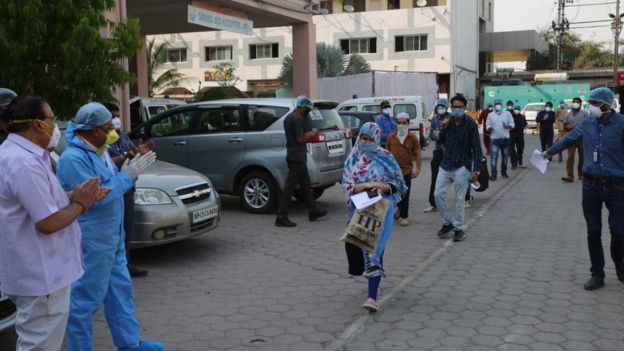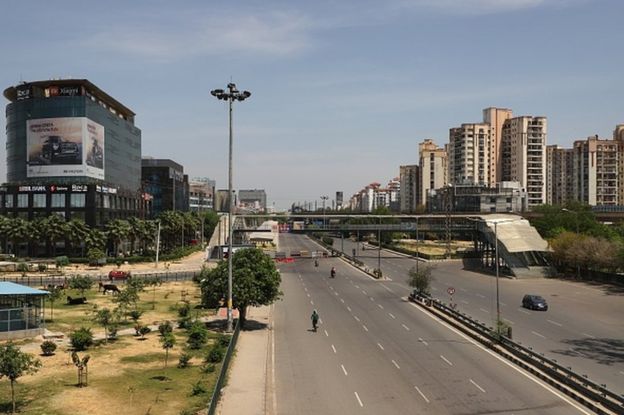
India has conducted some 180,000 tests so far – Getty Images
At the weekend, Prime Minister Narendra Modi said the next three to four weeks would be “critical” to prevent the spread of coronavirus in India.
Ever since its first case was confirmed on 30 January, India has taken a number of measures to try and combat the coronavirus. It has eased testing eligibility and invoked a draconian 122-year-old colonial-era epidemic disease law to restrict public gatherings, among other things. Now it is set to extend a strict three-week lockdown – scheduled to end on 15 April – until the end of the month. More than a billion people continue to stay at home and land, rail and air transport remain suspended.
There have been some 180,000 tests for the infection so far. Some 4.3% of the samples have tested positive. The contagion has killed 273 people. It has reportedly spread to nearly half of the country’s 700-odd districts. Several hotspots have been identified.
Global health experts are keenly looking at how India battles the virus. Its dense population, vast geography and weak public health system can easily overwhelm the best efforts to contain the spread of infection. “It is something which is worrying a lot of people, ” a leading virologist told me, insisting on anonymity. “It is early days yet in the trajectory of the virus here. In three to four weeks, the picture will be clearer.”
Economist Shamika Ravi, a senior fellow at the Brookings Institution who is closely tracking the infection, believes India is not doing badly. She says the number of active cases is doubling every seven days, a slower rate than before. The death rate is still low but rising.
“Our [infection] growth rate is highly contained despite the fact that we are actively chasing the fire,” she told me. “Almost all of our testing has been driven by protocol, starting with people with travel history, contact tracing of people in touch with them and so on. The probability of getting more positive cases [from this cohort] would have been much higher.”
Many are also pointing to the lack of reports about any surge in hospital admissions with influenza-like illness and COVID-19 patients, which would hint at a rapid community transmission.

A hospital in Indore has reported a surge of cases
But this may well be because of lack of information or weak reporting. A private hospital in the central city of Indore, as I reported, is already seeing a surge of cases and treating more than 140 COVID-19 patients, with nearly a third in critical care. At the weekend the hospital was reporting around 40 fresh cases a day. “We thought the transmission was going down, but our case-load went up suddenly over two days,” Dr. Ravi Dosi, a chest specialist, at the hospital, told me.
Others like T Jacob John, a retired professor of virology at Christian Medical College, Vellore, believe India must prepare for the worst.
“I don’t think we have yet understood the enormity of the problem that is likely to befall us in the next two months,” he told me. “For much too long the virus dictated our responses rather than the other way round”.
Dr. John says India’s response has been largely “evidence-based and reactive when it should have been projection-based and pro-active”.
India’s health ministry has strenuously denied there has been community transmission even as doctors from all over the country say they have been seeing patients with COVID-19 like symptoms from early March. “The entire focus seems to on finding evidence of community transmission, It’s a tactical error,” says Dr. John. “We all know community transmission is there.”
Dr. Ravi believes that going forward, “every week is critical now”.
Easing the lockdown to prevent an economic meltdown and flattening the curve of the virus will now require more surveillance testing to find out who’s infected and who’s not.

India is officially still denying community transmission – Getty Images
India would then need millions of testing kits and trained manpower to handle the process. Testing is also a highly involved process, which includes ensuring a cold chain for and smooth transport of tens of thousands of samples to the labs. India’s resources are finite and capacity is limited. One way to get around this, says Dr. Ravi, is “pool testing”.
This involves collecting a number of samples in a tube and testing them with a single real-time coronavirus test based on swabbing of the nose and throat, as recommended by the WHO.
If the test is negative, all the people tested are negative. If it’s positive, every person has to be tested individually for the virus. “Pool testing” reduces the time needed to test large swathes of the population. “If there’s no trace of the infection in some districts, then we can open them up for economic activity,” says Dr. Ravi.
Virologists believe that India should also do mass anti-body testing – a finger prick blood test to look for the presence of protective antibodies.
The blood test is easier and quicker to scale up than, say administering polio drops for immunization, which India has successfully done. “We need antibody testing as a public health tool rather than a diagnostic tool,” says one virologist. “We need to identify people who have recovered from the infection and send them back to work because they are no longer at risk.”
Along with this, India needs to look at plasma therapy, virologists I spoke to said. This involves using blood with consent from patients who have successfully fought the infection. This antibody-rich blood plasma can be infused into sick patients. Many doctors say it is a “hopeful milestone’ in treating the disease.
Most virologists I spoke to are unanimous that India should be testing “much, much more”. Ideally, one of them told me, any person with “any upper respiratory tract infection” should be eligible for a test.
India doesn’t have a culture of testing for infectious diseases because most citizens cannot afford them. Risk mitigation is not ingrained in the culture.

India has been under a lockdown since 24 March – Getty Images
“We tend to treat instead of testing. We rely on medical signs and symptoms [of a disease] rather than the cause or set of causes of a disease or condition,” a virologist observed. “We do tests only when we are sick.”
It is all right, says Dr. John, that the government is “fighting the war on the virus with the might of its administrative muscle”. But that might be not enough.
Many complain that beyond motivational appeals by the prime minister and routine briefings by bureaucrats, information around the transmission of the virus and scale of testing has been often opaque and evasive. Wearing masks was made mandatory only last week.
With its excellent public health system and response, only the southern state of Kerala appears to have flattened the curve so far. “This is going to be a long haul. We can’t be treating India as one episode of flattening the curve and be done with it. The virus doesn’t lose virulence,” says a virologist. “And all the states are not going to see a rise and fall in the curve at the same time.”
The weeks ahead will possibly tell us whether India will face an exponential rise in infections or begin to flatten the curve. “This is a thousand-piece jigsaw puzzle. There are not going to be any easy answers,” says Dr. John.

- A SIMPLE GUIDE: How do I protect myself?
- AVOIDING CONTACT: The rules on self-isolation and exercise
- HOPE AND LOSS: Your coronavirus stories
- LOOK-UP TOOL: Check cases in your area
- VIDEO: The 20-second hand wash
- STRESS: How to look after your mental health
Source: https://www.bbc.com/news/world-asia-india-52265061
[Disclaimer]











